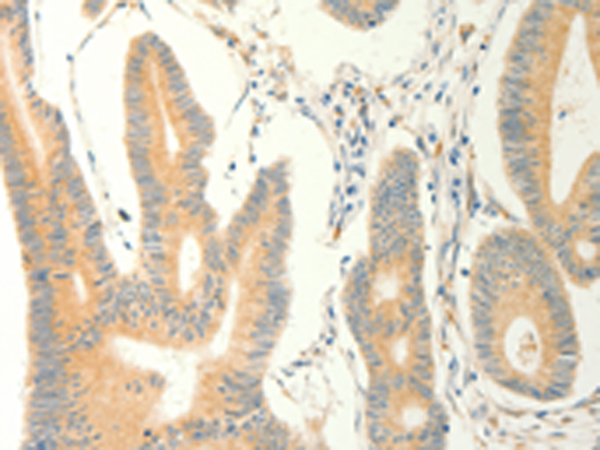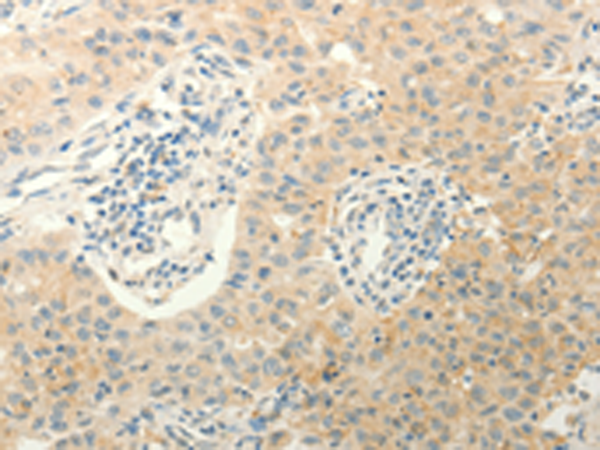


| WB | 咨询技术 | Human,Mouse,Rat |
| IF | 咨询技术 | Human,Mouse,Rat |
| IHC | 1/50-1/200 | Human,Mouse,Rat |
| ICC | 技术咨询 | Human,Mouse,Rat |
| FCM | 咨询技术 | Human,Mouse,Rat |
| Elisa | 1/2000-1/5000 | Human,Mouse,Rat |
| Aliases | p55; erg-3 |
| WB Predicted band size | 54 kDa |
| Host/Isotype | Rabbit IgG |
| Antibody Type | Primary antibody |
| Storage | Store at 4°C short term. Aliquot and store at -20°C long term. Avoid freeze/thaw cycles. |
| Species Reactivity | Human, Mouse |
| Immunogen | Fusion protein of human ERG |
| Formulation | Purified antibody in PBS with 0.05% sodium azide and 50% glycerol. |
+ +
以下是3篇与PARP1抗体相关的参考文献及其摘要概括:
---
1. **文献名称**:*Poly(ADP-ribose) polymerase-1 (PARP-1) and its role in DNA repair and apoptosis*
**作者**:Schreiber V, Dantzer F, Ame JC, de Murcia G
**摘要**:该研究系统阐述了PARP1在DNA单链断裂修复中的核心作用,通过使用特异性PARP1抗体(如Western blot和免疫沉淀)验证其与DNA损伤位点的结合,并证明PARP1抑制剂可增强放疗/化疗敏感性。
---
2. **文献名称**:*PARP1: Structural insights and pharmacological targets in cancer therapy*
**作者**:Amé JC, Spenlehauer C, de Murcia G
**摘要**:研究者通过单克隆PARP1抗体验证了其酶活性结构域,并利用免疫组化技术发现PARP1在乳腺癌组织中的高表达与患者预后不良相关,为PARP抑制剂开发提供实验依据。
---
3. **文献名称**:*Immunodetection of poly(ADP-ribose) polymerase cleavage during apoptosis*
**作者**:Soldani C, Lazze MC, Scovassi AI
**摘要**:该文献建立了一种基于PARP1抗体(识别89 kDa切割片段)的Western blot方法,用于特异性检测细胞凋亡过程中caspase介导的PARP1裂解,成为凋亡研究的经典标志物。
---
**补充说明**:上述文献中提到的PARP1抗体多用于功能研究(如DNA修复、凋亡检测)或临床相关性分析(如肿瘤组织表达)。实际应用中需结合具体实验(如ChIP、IF等)选择经过验证的商业化抗体(如Cell Signaling Technology #9532)。
Poly(ADP-ribose) polymerase 1 (PARP1) is a nuclear enzyme critical for DNA repair, genome stability, and cellular stress responses. It catalyzes the addition of poly(ADP-ribose) chains (PARylation) to target proteins, facilitating the recruitment of DNA repair machinery to sites of single-strand breaks. PARP1 also regulates processes like chromatin remodeling, transcription, and apoptosis. Dysregulation of PARP1 is linked to cancer, neurodegenerative disorders, and inflammation.
PARP1 antibodies are essential tools for studying its expression, localization, and function. These antibodies are widely used in techniques such as Western blotting, immunofluorescence, immunohistochemistry, and immunoprecipitation to detect PARP1 protein levels or its cleavage products (e.g., during apoptosis). Specific antibodies can distinguish between full-length PARP1 (∼116 kDa) and its caspase-cleaved forms (∼89 kDa), serving as apoptosis markers. Some antibodies also detect PARylation activity, aiding in functional studies of PARP1 inhibition.
In cancer research, PARP1 antibodies help evaluate PARP1 as a biomarker or therapeutic target, particularly in homologous recombination-deficient cancers treated with PARP inhibitors (e.g., olaparib). Commercial PARP1 antibodies vary in specificity, with validation required for each application. Cross-reactivity with PARP family members (e.g., PARP2) should be considered. Overall, PARP1 antibodies remain pivotal in advancing molecular and clinical research on DNA damage response and targeted therapies.
×